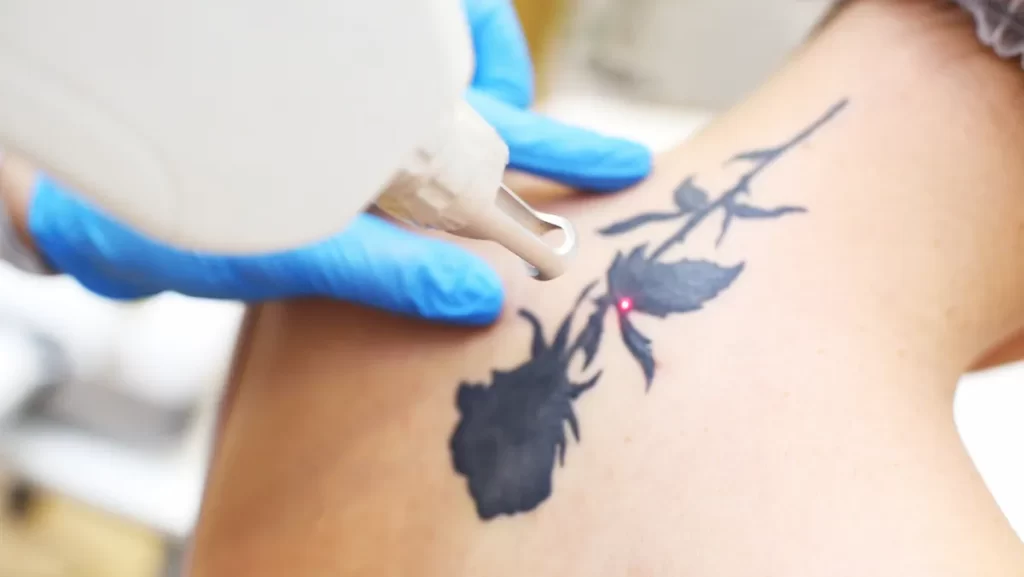Tattoos are a form of self-expression, but they can also become a reminder of choices we’ve outgrown or designs we no longer resonate with. At Delphi Skin Clinic, we understand that your skin tells a story, and we’re here to help you shape it as you desire. Q-Switched Laser Tattoo Removal in Anna Nagar is a highly effective and non-invasive procedure that targets tattoo ink, breaking it into smaller particles that your body can naturally eliminate.
Our advanced Q-Switched Laser technology at Delphi Skin Clinic in Anna Nagar allows us to treat tattoos of all colors and sizes, providing a safe and efficient solution for Laser Tattoo Removal. Whether you’re looking to completely erase a tattoo or lighten it for a cover-up, our expert practitioners can tailor the treatment to your specific needs.
How Q-Switch Lasers Work
Q-switched lasers are a type of laser technology used for various dermatological and cosmetic procedures. Here’s how Q-switch lasers work:
- Q-Switching Mechanism: The term “Q-switch” refers to the quality factor, which is a measure of the efficiency of a laser. Q-switching involves creating short, high-intensity pulses of laser energy.
- Energy Storage: Q-switch lasers use a special device called a Q-switch that stores energy within the laser cavity for a brief period.
- Rapid Release of Energy: When the stored energy reaches a peak level, the Q-switch is activated to release the energy in an extremely short burst, typically in the nanosecond or picosecond range.
- Selective Targeting: The rapid release of energy creates a high-powered laser beam with a specific wavelength. This intense, short-duration pulse selectively targets pigmented particles, like tattoo ink or melanin in the skin, while minimizing damage to surrounding tissues.
- Applications: Q-switch lasers are commonly used for tattoo removal, pigmented lesion treatment (such as age spots and freckles), and addressing certain skin conditions like melasma.
Q-switched laser tattoo removal treatments
- Q-switched laser: Uses high-intensity laser pulses to break down tattoo pigments.
- Selective photothermolysis: Targets specific colours without damaging surrounding skin.
- Multiple sessions: Typically requires multiple sessions for optimal results.
- Interval sessions: spaced weeks apart to allow skin to heal between treatments.
- Topical anaesthetics: Used to minimize discomfort during the procedure.
- Post-treatment care: Includes protecting the treated area from sun exposure and following skin care instructions.
- Minimal scarring: Q-switched laser helps reduce the risk of scarring compared to other methods.
- Effective for Multiple Colours: Suitable for different tattoo ink colours.
- Consultation: Essential to assess tattoo characteristics and determine the appropriate treatment plan.
- Patient Expectations: Realistic expectations of gradual fading and possible ink removal.
Risks and complications of Q-switched laser tattoo removal
- Pigment changes: Change in skin pigmentation, either darkening or lightening.
- Scarring: Although rare, scarring can occur, especially with improper aftercare or excessive treatments.
- Incomplete removal: Some tattoos may not fade completely, requiring additional sessions.
- Infection: Risk of infection if post-treatment care is not followed carefully.
- Allergic reactions: Possible allergic reaction to tattoo ink or treatment.
- Hyperpigmentation: Darkening of the treated area, especially in people with darker skin tones.
- Hypopigmentation: Lightening of the skin, more common in people with lighter skin.
- Blistering: Temporary blistering, is typically part of the healing process.
- Texture changes: Changes in skin texture or uneven healing.
- Herpes reactivation: People with a history of oral herpes may experience reactivation.
It’s important to consult a qualified professional for a thorough evaluation and to discuss potential risks before undergoing Q-switched laser tattoo removal.
Embark on the journey to a tattoo-free future with our meticulous Q-Switched Laser Tattoo Removal procedure:
- Consultation: Your experience with Laser Tattoo Removal in Anna Nagar begins with a thorough consultation at Delphi Skin Clinic. Our expert practitioners assess your tattoo, discuss your goals, and create a personalized treatment plan tailored to your needs.
- Preparation: Before the procedure, your tattoo is cleansed, and a topical numbing cream may be applied to enhance your comfort during treatment.
- Laser Application: Our state-of-the-art Q-Switched Laser is used to target and break down the tattoo ink. The laser emits rapid pulses of light energy that are absorbed by the ink, causing it to shatter into tiny particles.
- Recovery: Following the treatment, you may experience mild redness, swelling, or blistering, which is a natural part of the healing process. Over time, your body will gradually eliminate the shattered ink particles.
- Results: With each session, you’ll notice a fading of the tattoo. The number of sessions required depends on the size, color, and age of the tattoo. Many clients achieve significant tattoo removal or lightening for a cover-up.
Types of Q-Switched Laser Tattoo Removal
Q-switched laser tattoo removal includes:
- Ruby Laser: Suitable for green and blue pigments.
- Alexandrite Laser: Effective for black, green, and blue inks.
- Nd: YAG Laser (1064 nm): Targets black, blue, and green inks on darker skin.
- Nd: YAG Laser (532 nm): Addresses red, orange, and yellow pigments.
- Picosecond Lasers: Deliver ultra-short pulses for faster and more effective removal. The choice depends on the tattoo’s colors and the patient’s skin type.
Discover the remarkable benefits of Q-Switched Laser Tattoo Removal in Anna Nagar at Delphi Skin Clinic:
- Effective Tattoo Removal: Q-Switched Laser technology is highly effective at removing tattoos of all colors, sizes, and complexities.
- Versatile: Our advanced laser can target a wide range of tattoos, providing you with flexibility in your tattoo removal or modification journey.
- Non-Invasive: Tattoo removal with Q-Switched Laser is non-invasive and does not involve surgery or scarring.
- Improved Confidence: Removing or modifying a tattoo that no longer reflects your identity can boost your self-confidence and help you feel more comfortable in your skin.
- Customized Treatment: Our expert practitioners tailor each treatment to your unique tattoo and goals, ensuring optimal results.
Side Effects of Tattoo Removal
Common side effects of tattoo removal include temporary redness, swelling, blistering, and pinpoint bleeding at the treatment site. The skin may also temporarily become lighter or darker. Scarring and infection are rare but possible risks. It’s crucial to follow aftercare instructions and seek professional advice to minimize complications. Laser removal sessions are typically spaced several weeks apart to allow healing between treatments.
Delphi Skin Clinic is your premier destination for Q-Switched Laser Tattoo Removal in Anna Nagar, Chennai. Here’s why you should trust us with your journey to a tattoo-free future:
- Expertise: Our team of experienced practitioners is deeply committed to providing the highest level of care and expertise in Q-Switched Laser Tattoo Removal.
- Cutting-Edge Technology: We invest in the latest Q-Switched Laser techniques and equipment, ensuring that our treatments are safe, precise, and effective.
- Customized Solutions: We understand that each tattoo is unique. We customize our tattoo removal treatments to address your specific tattoo and goals.
- Outstanding Outcomes: At Delphi Skin Clinic, excellence is our standard. Our clinic consistently achieves exceptional results, leaving our clients thrilled with their tattoo-free or modified skin.
- Client-Centric Experience: Your satisfaction is our utmost priority. We provide a warm and welcoming environment, ensuring your experience with us is comfortable and enjoyable from start to finish.
Experience the liberating feeling of a tattoo-free or modified future at Delphi Skin Clinic. Contact us today to schedule your consultation for laser tattoo removal in Anna Nagar and embark on the journey toward clearer, more confident skin. Your story deserves nothing less than the best, and at Delphi Skin Clinic, we make that a reality.

